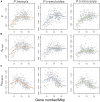Natural Selection and Recombination Rate Variation Shape Nucleotide Polymorphism Across the Genomes of Three Related Populus Species
- PMID: 26721855
- PMCID: PMC4788117
- DOI: 10.1534/genetics.115.183152
Natural Selection and Recombination Rate Variation Shape Nucleotide Polymorphism Across the Genomes of Three Related Populus Species
Abstract
A central aim of evolutionary genomics is to identify the relative roles that various evolutionary forces have played in generating and shaping genetic variation within and among species. Here we use whole-genome resequencing data to characterize and compare genome-wide patterns of nucleotide polymorphism, site frequency spectrum, and population-scaled recombination rates in three species of Populus: Populus tremula, P. tremuloides, and P. trichocarpa. We find that P. tremuloides has the highest level of genome-wide variation, skewed allele frequencies, and population-scaled recombination rates, whereas P. trichocarpa harbors the lowest. Our findings highlight multiple lines of evidence suggesting that natural selection, due to both purifying and positive selection, has widely shaped patterns of nucleotide polymorphism at linked neutral sites in all three species. Differences in effective population sizes and rates of recombination largely explain the disparate magnitudes and signatures of linked selection that we observe among species. The present work provides the first phylogenetic comparative study on a genome-wide scale in forest trees. This information will also improve our ability to understand how various evolutionary forces have interacted to influence genome evolution among related species.
Keywords: Populus; natural selection; nucleotide polymorphism; recombination; whole-genome resequencing.
Copyright © 2016 by the Genetics Society of America.
Figures





Similar articles
-
Genome resequencing reveals multiscale geographic structure and extensive linkage disequilibrium in the forest tree Populus trichocarpa.New Phytol. 2012 Nov;196(3):713-725. doi: 10.1111/j.1469-8137.2012.04258.x. Epub 2012 Aug 3. New Phytol. 2012. PMID: 22861491
-
Variation in Linked Selection and Recombination Drive Genomic Divergence during Allopatric Speciation of European and American Aspens.Mol Biol Evol. 2016 Jul;33(7):1754-67. doi: 10.1093/molbev/msw051. Epub 2016 Mar 15. Mol Biol Evol. 2016. PMID: 26983554 Free PMC article.
-
Functional and evolutionary genomic inferences in Populus through genome and population sequencing of American and European aspen.Proc Natl Acad Sci U S A. 2018 Nov 13;115(46):E10970-E10978. doi: 10.1073/pnas.1801437115. Epub 2018 Oct 29. Proc Natl Acad Sci U S A. 2018. PMID: 30373829 Free PMC article.
-
The relations between recombination rate and patterns of molecular variation and evolution in Drosophila.Annu Rev Genet. 2014;48:383-403. doi: 10.1146/annurev-genet-120213-092525. Epub 2014 Sep 10. Annu Rev Genet. 2014. PMID: 25251853 Review.
-
Ancestral Population Genomics.Methods Mol Biol. 2019;1910:555-589. doi: 10.1007/978-1-4939-9074-0_18. Methods Mol Biol. 2019. PMID: 31278677 Review.
Cited by
-
Evolutionary Genomics of Peach and Almond Domestication.G3 (Bethesda). 2016 Dec 7;6(12):3985-3993. doi: 10.1534/g3.116.032672. G3 (Bethesda). 2016. PMID: 27707802 Free PMC article.
-
Demography and Natural Selection Have Shaped Genetic Variation in the Widely Distributed Conifer Norway Spruce (Picea abies).Genome Biol Evol. 2020 Feb 1;12(2):3803-3817. doi: 10.1093/gbe/evaa005. Genome Biol Evol. 2020. PMID: 31958121 Free PMC article.
-
Genome sequence and genetic diversity of European ash trees.Nature. 2017 Jan 12;541(7636):212-216. doi: 10.1038/nature20786. Epub 2016 Dec 26. Nature. 2017. PMID: 28024298
-
Determinants of the Efficacy of Natural Selection on Coding and Noncoding Variability in Two Passerine Species.Genome Biol Evol. 2017 Nov 1;9(11):2987-3007. doi: 10.1093/gbe/evx213. Genome Biol Evol. 2017. PMID: 29045655 Free PMC article.
-
A major locus controls local adaptation and adaptive life history variation in a perennial plant.Genome Biol. 2018 Jun 4;19(1):72. doi: 10.1186/s13059-018-1444-y. Genome Biol. 2018. PMID: 29866176 Free PMC article.
References
Publication types
MeSH terms
Substances
LinkOut - more resources
Full Text Sources
Other Literature Sources

